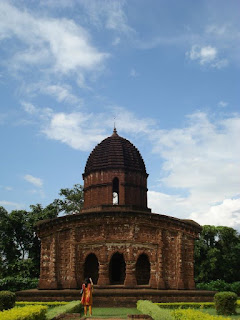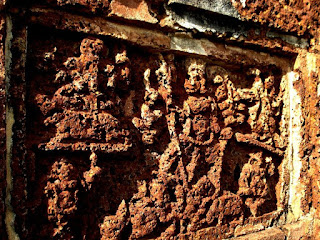Take
a listen to Tahsan and The Sufis – a band from Bangladesh, absolutely terrific velvety voice! Tahsan is an actor in addition to being a singer, he also sings solo.
Next
there’s The Trap also from Bangladesh with their title Thikana (Address) which gives
its name to the album – the other tracks
aren’t too bad either, and Tumi nei (You aren’t there) also fits the letter of
the day.
A
young duo from Kolkata, Taalpatar Shepai, with the fun track Ami shudhu khujechi amay (I’ve only
searched for myself) -
And finally, this medley which is a Tribute to Tagore - I can't let T-day pass without mentioning this towering personality - so. Young artistes covering his songs with modern music arrangements but treating the original with due respect. Great job. Though Tagore isn't just about music and lyrics, he was one guy who was elbow deep in every possible creative pie and changed all the recipes forever in Bengal.
Terracotta...Temples...Textiles
If
you scoot off from Kolkata roughly in the northwestern direction you’ll reach
Bishnupur after about 150 kms. On its own, its nothing extraordinary - a regular small town scattered on the red soils of the Bankura district. Till you get
to the temples, that is.
The
story goes that a forest-dwelling, tribal woman found a newborn baby and his
dead mother one morning when she went to collect firewood. Turned out the
mother was a noblewoman who had fallen behind her entourage because of the
onset of labour and died shortly after giving birth. The woman brought the baby
home, called him Raghunath, and he grew up to be one of those hunky, six-pack rippling
wrestler types who could kill tigers with bare hands and tame elephants with a glance…you
get the picture. He was titled locally as Adimalla, which roughly means the
Original Wrestler and he evolved into the 1st Malla king, the founder of a
dynasty which came to rule Bishnupur for many long centuries. The kingdom was known as Mallabhum (the land
of Mallas). While the legend may or may not be based on truth, the dynasty indubitably
dates back to a remote time just before 700 CE.
Bishnupur
is famed today for three things – the Bishnupur Gharana (= tradition/school) of
classical Hindustani music, the Baluchari saree, and the terracotta temples
built over half a century by various Malla rulers. The profusion and the workmanship
of the temples especially testify to the opulence of the Mallabhum capital during
in mid-17th century, and to the sophistication of its clay artisans and
builders.
Incidentally,
because Bengal was geographically a delta region and it did not have any locally
available stone, unlike other parts of India, the tradition of stone temples never
existed in Bengal. Instead the plentifully available clay was scooped and baked
into terracotta panels and bricks to be used as building materials. And not
just building materials but also as a medium for art, contemporary terracotta
art from the Bishnupur/Bankura area and Bengal generally is famed across India.
Bir
Hambir, the 49th ruler of the Malla dynasty, was originally a pretty
dodgy king and a tyrant. But he turned over a new leaf after he was converted to
Vaishnavism by a disciple of Sri Chaitanya and a renowned scholar, Srinivas. Vaishnavism,
as you know, is the cult of Hinduism that worships Vishnu in his many avatars –
especially Krishna. Once converted, Hambir went on to introduce the worship of
Krishna and built the Ras Mancha in Bishnupur, where all the deities from the
surrounding temples were gathered during the time of the Ras festival.
 |
| Ras Mancha |
Hambir’s
son Raghunath was given the title of Singha (Lion) by the Mughal Subahdar
(governor) Shah Suja at some astonishing
feat of bravery. Raghunath built several temples and during his time Bishnupur
became renowned as a centre of music and Sanskrit scholarship. From 1622 till about
1702, many Vaishnav temples were built, as also large tanks called bandhs. Not
just the king was involved but some of their consorts also erected temples to
Krishna. During this time the capital was fortified also, though the fort is
mostly in ruins, some canons remain there as proof of the power and breadth of
the Malla dynasty. From the early 18th century the kingdom faced
hard times as the Marathas attacked the delta regions from the west. By early
19th Mallabhum came under EIC rule and subsequently became part of
the Raj.
 |
| Corridor detail Ras Mancha |
There
are in total around thirty temples in Bishnupur, mostly in a good state of preservation.
These are quite magnificent in their architecture and particularly so in the exquisite
artistry of the terracotta panels used in the buildings. They depict mythological scenes from the epics
– Mahabharata, Ramayana and Krishna-lila, and also vegetal and geometric, repetitive
patterns.
The panels also contain scenes of ordinary, day-to-day life – such as bullock carts on their way to the market, a bride in a palanquin being taken to her marital home, or nobles out hunting. Warfare is a commonly depicted subject and gives an idea of the kind of weaponry that was common in those times. Similarly, images of divine musicians (Gandharvas) making music are also commonly found and indicate the panoply of musical instruments in classical Indian music of the era.
Many of these motifs have found their way into the borders and the pallav of Baluchari sarees, which is the other speciality of Bishnupur. Contemporary handloom weavers use the temple motifs as inspiration for weaving silk sarees even today.
The panels also contain scenes of ordinary, day-to-day life – such as bullock carts on their way to the market, a bride in a palanquin being taken to her marital home, or nobles out hunting. Warfare is a commonly depicted subject and gives an idea of the kind of weaponry that was common in those times. Similarly, images of divine musicians (Gandharvas) making music are also commonly found and indicate the panoply of musical instruments in classical Indian music of the era.
Many of these motifs have found their way into the borders and the pallav of Baluchari sarees, which is the other speciality of Bishnupur. Contemporary handloom weavers use the temple motifs as inspiration for weaving silk sarees even today.
 |
| Jor Mondir built 1726. |
Most of the temples are built in a style that echoes the typical curvy-roofed
thatched cottage of Bengal, the style known as Bangla that has given English the word bungalow. The roof may slope on two
sides or four sides and can be topped by another similar curved roof in parallel,
or by one or multiple shikhars – spire type, small, squat round towers with pointy
finials. All in all they are quite groovy to look at – take a peek.
Posted for the A-Z Challenge 2019






You are right about Tahsan's voice. Rich, dark, melting chocolate...
ReplyDeleteHow I would love to see those temples. The architecture is incredible. How many modern buildings would survive as well? And how many would we want to preserve?
Ooh I'd want to preserve all old buildings every brick and stone every mark of the chisel, uber crazy about them. Not so much about the skyscrapers...though I guess they too will be much admired in 300-400 years, if they survive...
DeleteI have not heard about these temples, but terracotta architecture looks lovely, and now I have a new item on my "places to visit" list... :D
ReplyDeleteThe Multicolored Diary
It truly is a lovely artform...and I think it's unique to Bengal.
DeleteHow fascinating. I love reading the history of other places, particularly places with a looong history (here in Oz we are really quite a young country).
ReplyDeleteVisiting from A-Z
AJ Blythe
India as a whole is seriously ancient so plenty of material as far as the A-Z goes :)
DeleteTerracotta is so unique. The concentration of temples there would take a while to explore. Quite lovely.
ReplyDeleteYeah, definitely not a day trip kind of destination.
DeleteOh what gorgeous temples. I don't know that I've ever seen terracotta artwork panels before other than painted, but wow!
ReplyDeleteThe intricacy of the work is quite amazing. I don't think terracotta work like this exists outside of Bengal.
DeleteThe bricks made during slave times in the U. S. sometimes have the marks of hands or fingers in them. I imagine some of those bricks must also have the prints of the makers still there after all these centuries.
ReplyDeleteThat is an utterly fascinating thought. The hand of the past reaching out and touching the present, wow!
DeleteHow lovely to have mythological and domestic scenes inscribed onto these beautiful terracotta tiles ..
ReplyDeleteA lot of stuff can be inferred from the scenes of daily life - the type of transportation, crops, food habits, musical instruments, what all was in use at that time. So they are kind of a historical archive too.
DeleteBeautiful temples, and I love colorful sarees!
ReplyDelete